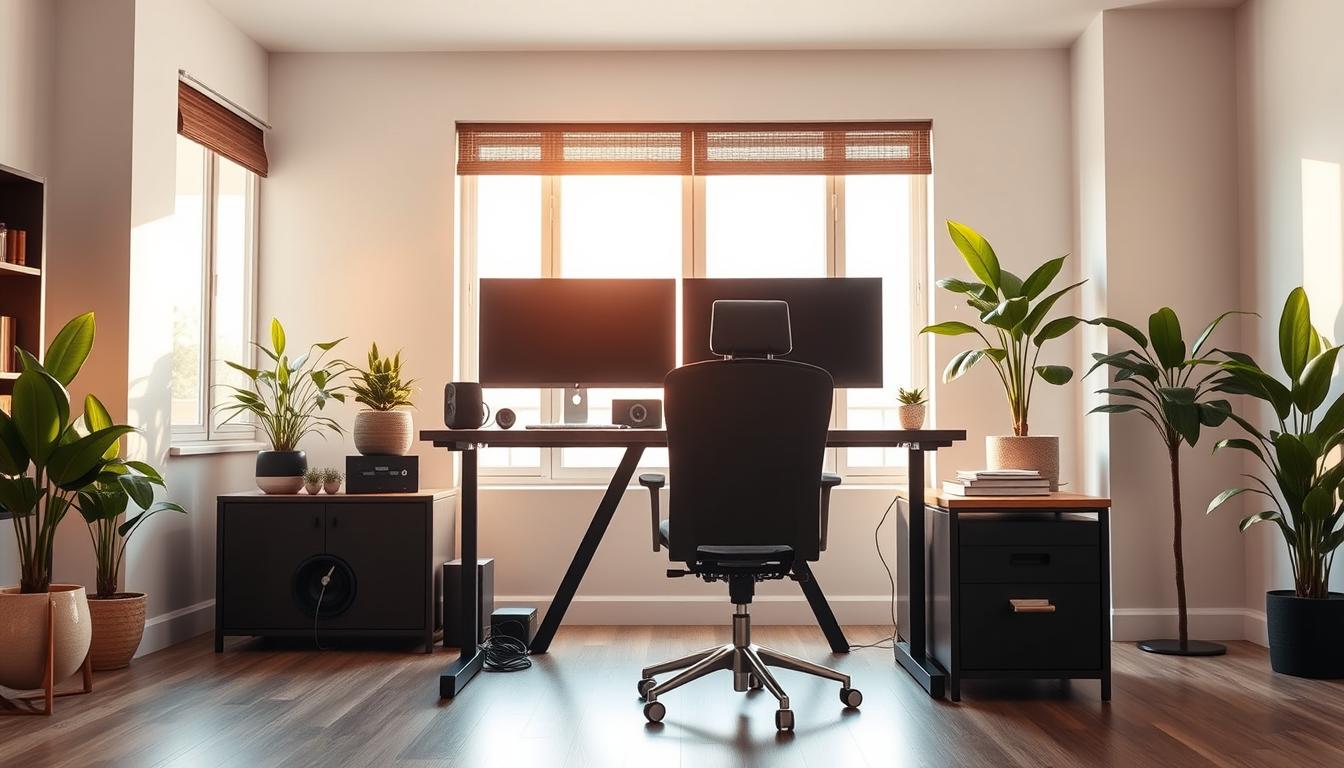Are you ready to change your workspace and boost your productivity? Discover the power of a standing desk and how it can change your home office routine. An adjustable desk riser can help fight back pain, improve focus, and increase your energy all day.
Did you know standing burns up to 20% more calories than sitting? Standing can strengthen your body and fight the bad effects of sitting too much, all while making you more productive. Say goodbye to the dreaded 3 p.m. slump and hello to a more refreshing work experience.
In this guide, we’ll show you how to set up a standing desk at home. We’ll make sure your workstation is set up for your comfort and health. We’ll cover adjusting the desk height and adding the right accessories. You’ll learn how to create a workspace that supports your active lifestyle and boosts your productivity. Get ready to take your home office to new heights!
The Importance of Good Ergonomics
Creating an ergonomic home office is key for your health and work performance. Good office ergonomics can greatly improve your work habits, posture, productivity, mental clarity, and energy. It’s all about making your workspace comfortable and efficient.
What Is Office Ergonomics?
Office ergonomics is about designing workspaces for comfort, efficiency, and safety. It involves the right desk setup and work area layout. Every detail in your environment affects your physical and mental health.
Benefits of Proper Office Ergonomics
- Musculoskeletal Disorders Risk Reduction: A well-designed ergonomic desk can lower the risk of musculoskeletal disorders. It helps keep your posture right and reduces muscle and joint strain.
- Productivity Increase: Being comfortable and pain-free boosts productivity. A comfortable workspace helps you stay focused and productive all day.
- Stress Reduction and Well-Being Improvement: An ergonomic workspace reduces stress, improves mood, and enhances overall well-being.
| Ergonomic Considerations | Benefits |
|---|---|
| Regular Breaks | Take breaks every 30-60 minutes to stretch and prevent stiffness. It keeps you productive. |
| Chair Adjustments | Adjust your chair and posture often to avoid static positions and stay comfortable. |
| Proper Lighting | Good lighting prevents eye strain and supports a comfortable work environment. |
| Temperature Control | A comfortable room temperature prevents fatigue and discomfort. |
| Noise Level Impact | Less noise means better focus and productivity in your workspace. |
| Tailoring the Workspace | Make your workspace visually appealing and comfortable for your preferences. It boosts productivity and well-being. |
Focus on office ergonomics and create a healthy work environment. It unlocks your full productivity and protects your health. Check out ways to enhance your home office for better posture and productivity.
Assembling Your Standing Desk
Step-by-Step Guide to Assembly
Setting up your standing desk at home is easy. Just follow this guide to put together your new workstation. Start by unpacking all parts and organizing them as the manual says. Read the manual first to know what to do.
- Identify all the parts and hardware included in the package, and lay them out in an organized manner.
- Consult the instruction manual and follow the step-by-step guide to assemble the desk frame. This typically involves connecting the base, legs, and crossbars.
- Once the frame is assembled, carefully place the desktop surface on top, aligning it with the frame as per the instructions.
- Secure the desktop to the frame using the provided screws or brackets, ensuring a stable and level surface.
- If your standing desk comes with additional features, such as a monitor mount or wire management system, install these components according to the manufacturer’s guidelines.
- Double-check all connections and tighten any loose screws to ensure the stability and safety of your standing desk setup.
With patience and care, you can set up your standing desk well. It will make your home office setup better and more productive.
| Feature | Benefit |
|---|---|
| Quick-install standing desks | Can take as little as 3 minutes to assemble (e.g., iMovR Lander) |
| Desks from China | Have an 8% industry rule of thumb for failure rate at installation |
| iMovR Energize desk | Requires about 20 minutes for assembly, with power tools recommended for efficiency |
| Non-quick-install desks (IKEA Bekant, SmartDesk 2) | Generally take 45 to 60 minutes to assemble |
| Lander L-desk line from iMovR | Requires 8 minutes to assemble but needs a screwdriver for one step |
| Desks under $700 (excluding iMovR Energize) | May take 45 to 90 minutes to assemble due to more manual setup requirements |
Proper standing desk assembly is key for a good DIY project in your home office setup. Take your time, follow the instructions, and enjoy your new ergonomic workstation!
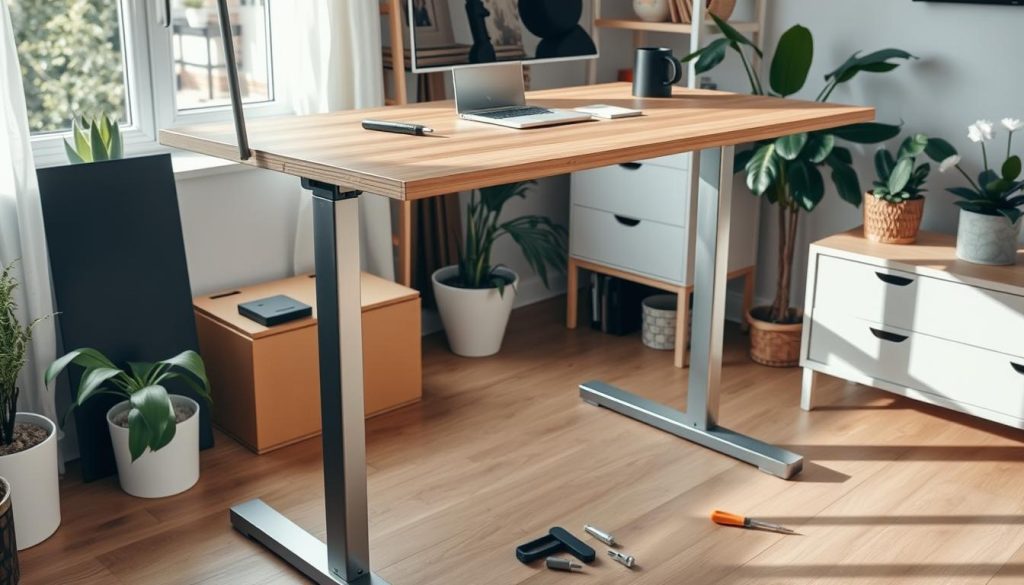
Positioning Your Standing Desk
Placing your standing desk in the right spot can greatly improve your work area. Think about where it is in relation to the door, windows, and other furniture. A well-planned layout helps you stay focused and work better.
It’s important to consider the standing desk placement near the door. This can help you avoid distractions. Or, you might prefer it away from the main path for a quieter spot.
The office layout and window placement matter too. A desk near a window can make you feel better and work better. But, don’t put it right in front of the window to avoid eye strain from sunlight.
| Desk Height | User Height |
|---|---|
| 36 in (91 cm) | 5’0″ (152 cm) |
| 39 in (99 cm) | 5’6″ (168 cm) |
| 42 in (107 cm) | 6’0″ (183 cm) |
| 45 in (114 cm) | 6’6″ (198 cm) |
Think about where other furniture goes in your workspace design. Positioning your standing desk with other items can make your space more efficient and comfortable.
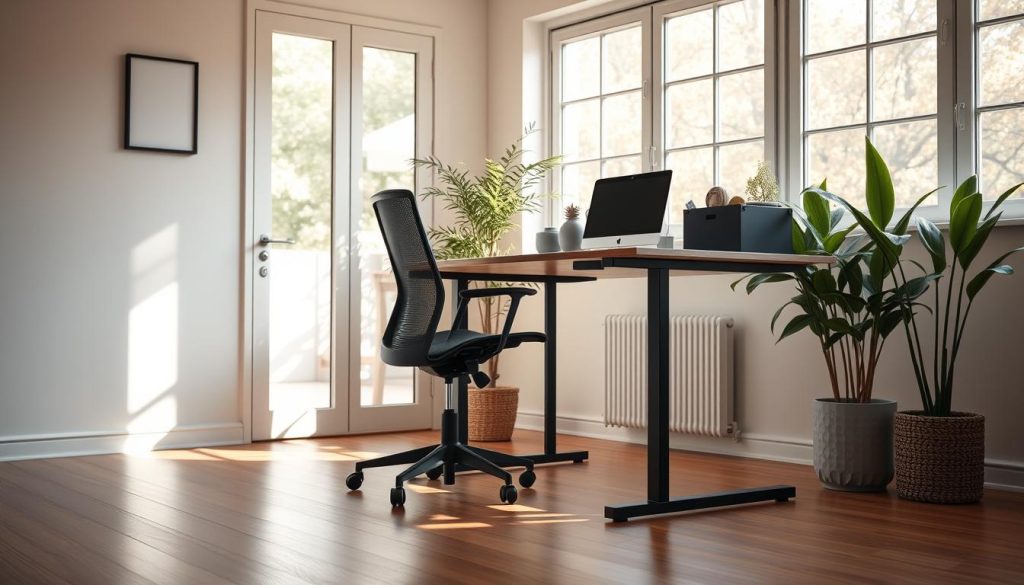
By carefully placing your standing desk, you can make a better work environment. Check out common mistakes and decor tips to improve your standing desk placement and workspace design.
Decluttering and Minimalism
Adopting a minimalist office can greatly improve your productivity and well-being. By decluttering your workspace, you create a calm space that boosts mental clarity and focus. Minimalism in your office is not just about looks; it also saves time, money, and mental effort.
Benefits of a Minimalist Workspace
Research indicates that digital tools can help clear up to 95-100% of physical clutter. Unfinished tasks on your desk can distract you for weeks, leading to mental clutter. Just 5 minutes each day to tidy up can become a habit, saving you time.
Having fewer items on your desk and using drawers for storage keeps your space organized. A cluttered desk can distract you from important tasks, with 81% feeling overwhelmed. Yet, 67% found a minimalist desk setup boosted their productivity.
A minimalist workspace design should reduce distractions to encourage creativity, with 93% agreeing. The desk is key, with 75% making it a priority. Adding hidden storage and ergonomic features like adjustable height are also vital, with 62% and 88% valuing them.
Choosing desks that are both comfortable and stylish is important, with 70% considering both. Natural materials like wood or metal are favored by 85%, and 79% see cable organizers as essential for a clean desk. Personal touches can also enhance a minimalist space, with 73% believing so.
Digital decluttering is just as important, with 94% valuing it for a streamlined digital workspace. Adding ergonomic furniture is also key for well-being, with 82% agreeing.
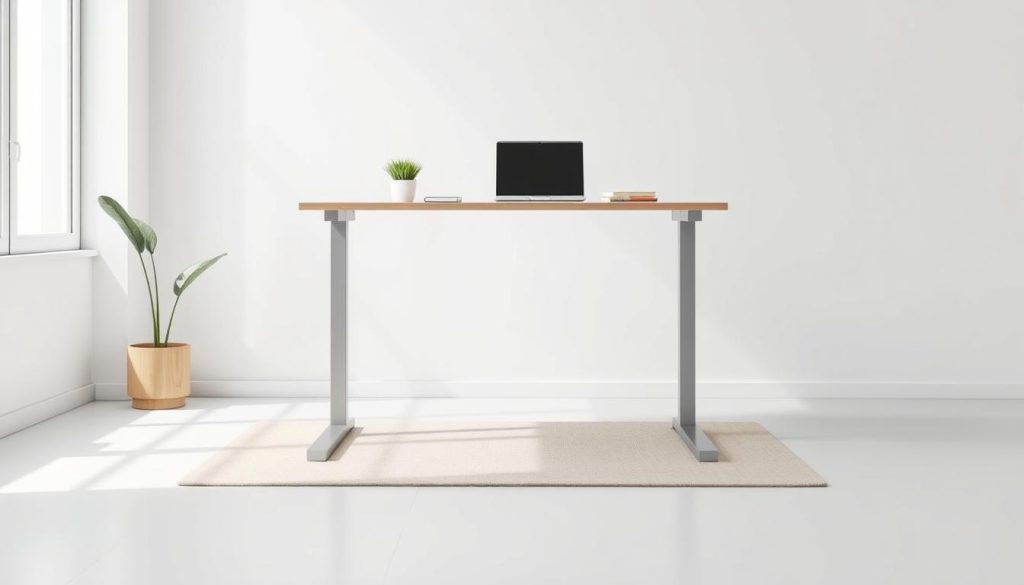
Set up standing desk home
Creating an ergonomic standing desk home office can change your work life. It makes your workspace better for your health and focus. By setting up your desk like your office, you can stay sharp and full of energy all day.
To make your standing desk home office great, follow these tips:
- Make sure your desk is the right height. Your elbows should be at 90 degrees when your arms are relaxed. This keeps your back and neck from getting sore.
- Put your computer monitor where you can see it easily. It should be close and at eye level. This stops your neck and back from hurting.
- Get a good ergonomic chair for when you sit. Switch between sitting and standing to keep your body happy.
- Use tips to stay productive. Set timers to move, use a mat for your feet, and keep things you need close. This helps you stay focused.
With a well-made ergonomic home workspace and a standing desk setup, your remote work setup will improve. You’ll feel better and work better too.
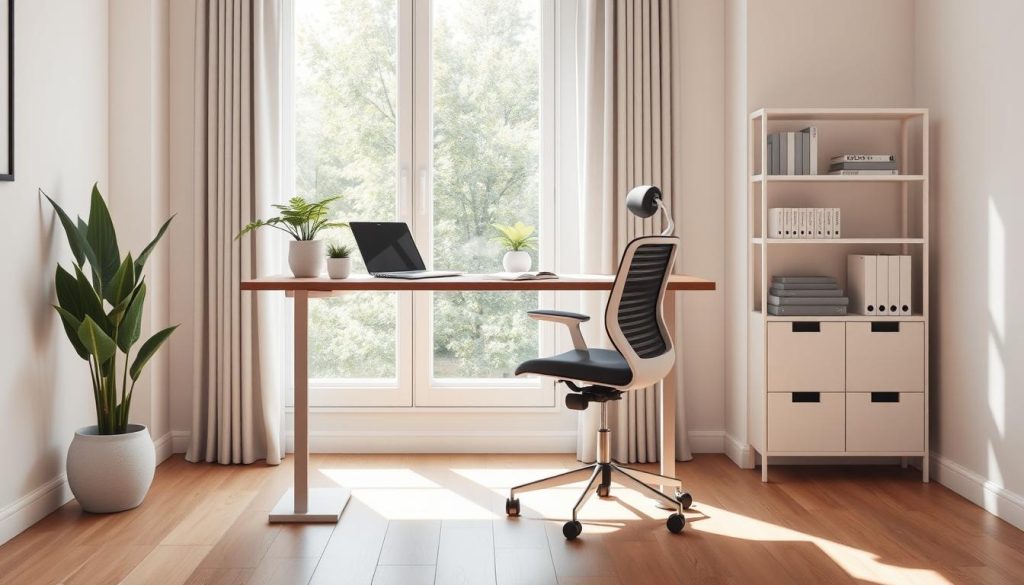
Replicating Your Office Environment
Working from home can be tough without a real office. Creating a space that looks and feels like your office can really help. It makes you feel more professional and boosts your productivity. Try to make your home office setup look like your office. This helps your brain get into work mode faster.
Creating Boundaries and Rules
Setting clear rules for your remote work environment is key. Pick a specific spot in your home for work. Don’t work from bed or couch. Keep a regular schedule, with breaks and time away from your desk.
Make rules to stay focused and productive. For example:
- Dress for work, even if it’s casual
- Stay away from social media and TV during work
- Tell family or roommates when you’re available
- Take breaks to stretch or walk
By copying your office’s structure and routines, you canincrease your productivity tipsand keep a goodwork-life balanceat home.
| Metric | Statistic |
|---|---|
| Percentage of individuals working from home due to COVID-19 | Significant increase compared to pre-pandemic levels |
| Percentage of individuals experiencing challenges with productivity while working from home for the first time | Considerable |
| Percentage of individuals reporting that creating a designated workspace improved their productivity | High |
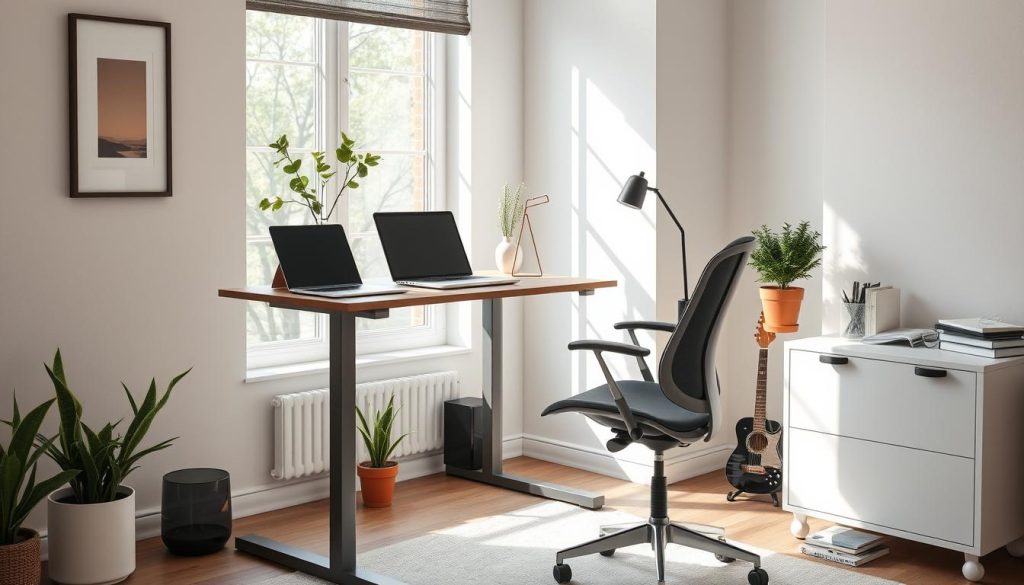
Personalizing Your Workspace
Making your standing desk your own is more than just looks. It can really boost your work and happiness. Adding things that show your style and interests makes your space feel like home. It brings comfort and sparks creativity.
Begin by personalizing your standing desk. Use photos, plants, or art that gets you pumped up. Also, add ergonomic stuff like monitor arms and mats for better comfort and looks.
Want to go further? Think about adding adjustable lights or a hammock under your desk. These small changes can greatly improve your space. They make it more to your liking and better for your mind and work.
The secret to a great office personalization is mixing looks with function. By picking the right items for your workspace design, you create a place that helps you work better. It also takes care of your mental well-being.
| Feature | Benefit |
|---|---|
| Height-adjustable standing desk | Reduced cardiovascular disease risk and improved blood circulation |
| Ability to shift positions | Significant reduction in muscle pain |
| Standing during work | Increased energy levels and productivity |
| Alternating sitting and standing | Prevents fatigue and promotes a healthier lifestyle |
By making your standing desk special, you create a space that shows who you are. It supports your productivity and mental well-being. Take the chance to make your office truly yours and enjoy all its benefits.
Proper Standing Posture
Using a standing desk right is key to avoid pain and health problems. To get your standing desk posture just right, remember these tips:
- Relax your shoulders and keep your elbows at a 90-degree angle.
- Distribute your weight evenly on both feet to maintain balance and stability.
- Consider using an anti-fatigue mat to provide additional support and comfort for your feet and legs, specially during long standing times.
Monitor Position and Height
Where you put your computer monitor is also super important for a healthy ergonomic setup. Place your monitor at or slightly below eye level to avoid neck strain. Keeping the top third of the screen at eye level helps keep your neck and back comfy.
| Recommendation | Benefit |
|---|---|
| Start with standing for 2 hours and gradually increase to 4 hours per day | Allows your body to adjust and reduces the risk of discomfort or fatigue |
| Maintain elbows at a 90-degree angle or greater | Promotes proper monitor positioning and reduces strain on the neck and shoulders |
| Use an anti-fatigue mat | Helps alleviate foot and leg fatigue by providing cushioning and support |
By sticking to these standing desk posture and monitor tips, you can keep your neck and back health in check. Adding breaks and adjusting your position often can also boost your comfort and work output.
Staying Active and Taking Breaks
A standing desk offers many benefits. But, standing for too long can be hard on your body. It’s key to take breaks and add physical activity to your day.
Studies show that short breaks for physical activity are better than sitting all day. Even if you sit the same amount, moving around helps a lot. Sadly, American adults sit for nearly eight hours a day. Over 80% of jobs in the U.S. are mostly sitting.
To fight the bad effects of sitting too much, try these tips:
- Use reminders to stand up and walk around every hour.
- Try balance boards or exercise balls to work your core and legs.
- Get a treadmill desk or mini exercise bike to move your legs all day.
- Do stretches or simple desk exercises during breaks to boost muscle strength, weight loss, and pain management.
- Drink lots of water to stay energized and healthy.
Focus on standing desk breaks, physical activity, and a good work-life balance to stay productive and healthy at home. A healthy lifestyle is vital for your physical and mental health.
| Activity | Benefits |
|---|---|
| Stretching | Reduces pain, stiffness, and fatigue; Improves energy levels |
| Balance Boards | Engages leg and core muscle groups; Challenges balance and stability |
| Treadmill Desks | Increases calorie expenditure; Keeps legs moving |
| Mini Exercise Bikes | Keeps legs moving; Works calf muscles |
The Science Behind Standing Desks
Physical Health Benefits
Standing desks offer many benefits for your health. They help fight the bad effects of sitting too much. This includes lower risks of heart disease, obesity, and back pain. Standing helps your muscles work and blood flow better, leading to better posture and more calories burned.
A 2016 study showed that call center workers with standing desks were 50% more productive. But, standing desks might not be good for everyone. People with heart disease or obesity might get tired easily from standing too long.
Mental Health Benefits
Standing desks also improve your mental health. Studies show that having plants in the office can make the air cleaner, reduce stress, and boost productivity. A 2017 study found that moving around and taking breaks can help you focus better at work.
It’s wise to talk to an ergonomics expert to set up your standing desk right. Start by standing for short periods and take breaks every 30 minutes to an hour. This helps prevent getting tired or uncomfortable.
| Study | Key Findings |
|---|---|
| 2016 study on call center employees | Call center employees with sit-stand desks were almost 50% more productive than their colleagues who sat in the office. |
| Seguin et al. (2014) | Highlighted sedentary behavior and its correlation with mortality in older women, found through the Women’s Health Initiative. |
| Bauman et al. (2011) | Presented a comparison of sitting habits across 20 countries using the International Physical Activity Questionnaire (IPAQ). |
| Boles et al. (2004) | Showed a relationship between health risks and productivity loss at work, with statistical figures to indicate the impact. |
Understanding the science behind standing desks helps you decide if they’re right for you. They can improve your physical health, mental well-being, and productivity.
Choosing the Right Standing Desk
Choosing the right standing desk for your home office is key for comfort and productivity. Look for ergonomic design, adjustability, and customization that fit your needs.
Features to Look For
First, check the recommended height range for standing desks. They usually adjust from 22 to 48 inches. This range suits most people, from the shortest to the tallest.
If you’re very tall, find a desk that goes up to 50 inches or more. Depth matters too, with most desks having at least 30 inches of space. This is enough for your computer and other important items. Also, make sure the desk can handle the weight of your gear.
- Choose electric or pneumatic adjustments for easy height changes. Avoid manual cranks.
- Get adjustable monitor arms for better display positioning.
- Think about a footrest if you’re shorter. It helps with standing comfort.
Try out different standing desks to find the best one for you. Testing various models helps you make a choice that supports your health and work efficiency.
Accessorizing Your Standing Desk
Improving your standing desk is more than just the desk itself. Adding the right accessories can make your workspace more comfortable and productive. Think about getting a top-notch ergonomic chair, like the Fern Collection. It supports your back and keeps you in good posture, even when sitting.
Look into items like the Desky Sit Stand Pro ergonomic stool for active sitting. Also, consider the Sky Solutions Anti-fatigue Mat for comfort while standing. Don’t forget the Desky Balance Board to keep your muscles active while standing.
To make your workspace even better, check out cable management kits and ergonomic accessories. The UpDown Bundle and Ergotron LX Single Monitor Arm help keep your space organized. The Desky Keyboard Tray adjusts to fit your needs and saves desk space. Top it off with the Xiaomi Mi Smart LED Desk Lamp Pro for better lighting and style.
Source Links
- https://www.halfhalfhome.com/work/standing-desk-tips.html
- https://store.haworth.com/blogs/articles/the-essential-standing-desk-setup-guide-for-first-timers?srsltid=AfmBOoplIk-VoO9oNy2NlPRNIXIWa9m7W3JU8ds4uctyK6Bhppfy9DqZ
- https://ergonofis.com/blogs/news/how-to-use-my-sitstand-desk-correctly?srsltid=AfmBOooulDh4LxKeZZ3Ff03fI0pKPQknOMyZfc8gO2vhd_qMPA4bgds4
- https://www.ohow.com/2021/02/08/standing-desk-ergonomics-7-benefits-of-standing-at-work/
- https://www.autonomous.ai/ourblog/the-importance-of-correct-ergonomic-desk-setup
- https://store.haworth.com/blogs/articles/the-essential-standing-desk-setup-guide-for-first-timers?srsltid=AfmBOoqIuhMacYdqCNIzo2k-mwH1aFtxh6HpAHwY-5t_Es5s45BALjA7
- https://www.workwhilewalking.com/how-hard-is-it-to-assemble-a-standing-desk
- https://effydesk.com/pages/how-to-assemble-your-height-adjustable-standing-desk?srsltid=AfmBOoonJMuJxaOj4AW-lOcYFWDTAlN8YSMQCHPBePuLPtU3FQhK_eW9
- https://store.haworth.com/blogs/articles/the-essential-standing-desk-setup-guide-for-first-timers
- https://www.chairoffice.co.uk/blog/how-to-use-a-standing-desk-correctly/
- https://www.becomingminimalist.com/minimalist-desk/
- https://www.branchfurniture.com/blogs/turn-key/minimalist-desk-setup?srsltid=AfmBOoqE4-qpxZVflyP720chEO8p2N-3Ku_dtxgtjkdwQlKa2KnDhmk0
- https://store.haworth.com/blogs/articles/the-essential-standing-desk-setup-guide-for-first-timers?srsltid=AfmBOooZpjgxzHNjw0SvtnsBJzgI-tzvyERMu1hI4_8ZhcwqYgViYB-v
- https://www.nytimes.com/wirecutter/reviews/how-to-set-up-standing-desk/
- https://www.autonomous.ai/ourblog/things-to-get-the-ideal-standing-desk-setup
- https://moviworkspace.com/blogs/how-to/the-how-to-guide-achieving-the-ideal-desk-setup-to-be-productive
- https://www.charlotteinsurance.com/blog/creating-productive-home-office-environment/
- https://www.autonomous.ai/ourblog/perfect-home-office-setup-with-a-standing-desk
- https://www.jin.net.in/blog/customizing-your-workspace-tips-for-personalizing-your-electric-height-adjustable-desk-setup/
- https://sihoooffice.com/blogs/guide/diy-standing-desk-guide-how-to-build-your-own-custom-workspace
- https://www.vari.com/resource-center-articles/rc-top-standing-desk-mistakes.html?srsltid=AfmBOor7h_yPFtWgluD8b5UfGwtztQofG5PTcO239o8F5r5myry1GZpz
- https://www.healthline.com/nutrition/6-tips-for-using-a-standing-desk
- https://store.haworth.com/blogs/articles/the-essential-standing-desk-setup-guide-for-first-timers?srsltid=AfmBOop887wmKfpLdHp4bqgo6sbpmlZGvvL2IfiqLpaJoKtMUG5BFWky
- https://beststandingdesks.com.au/ways-to-stay-active-at-your-standing-desk/
- https://neurorehabmd.com/5-ways-to-stay-active-at-your-sedentary-desk-job/
- https://livehealthy.muhealth.org/stories/cant-ditch-desk-5-ways-stay-active-work
- https://www.minimaldesksetups.com/how-standing-desks-benefit-productivity/
- https://www.ncbi.nlm.nih.gov/pmc/articles/PMC8582919/
- https://ergobuyer.com/how-to-choose-a-stand-up-desk/
- https://www.ergolink.com.au/blog/standing-desk-buyers-guide-part-1-what-type-of-desk-do-you-need
- https://medium.com/@darrenshrwd/every-sit-stand-desk-accessory-you-need-to-work-like-a-pro-331dc7f20d19
- https://store.haworth.com/blogs/articles/the-essential-standing-desk-setup-guide-for-first-timers?srsltid=AfmBOoosKmnWcPwVfFyTJFe39k4ymFDAGyFy4llQqxBPUJEMcZ42R1Nw
- https://www.progressivedesk.com/blogs/top-tips/10-essential-standing-desk-accessories?srsltid=AfmBOoosHchZHgXcWsIBEwkqdtVP5MWFA7ccK8G2ZWRvsHpubFDtNfp0

